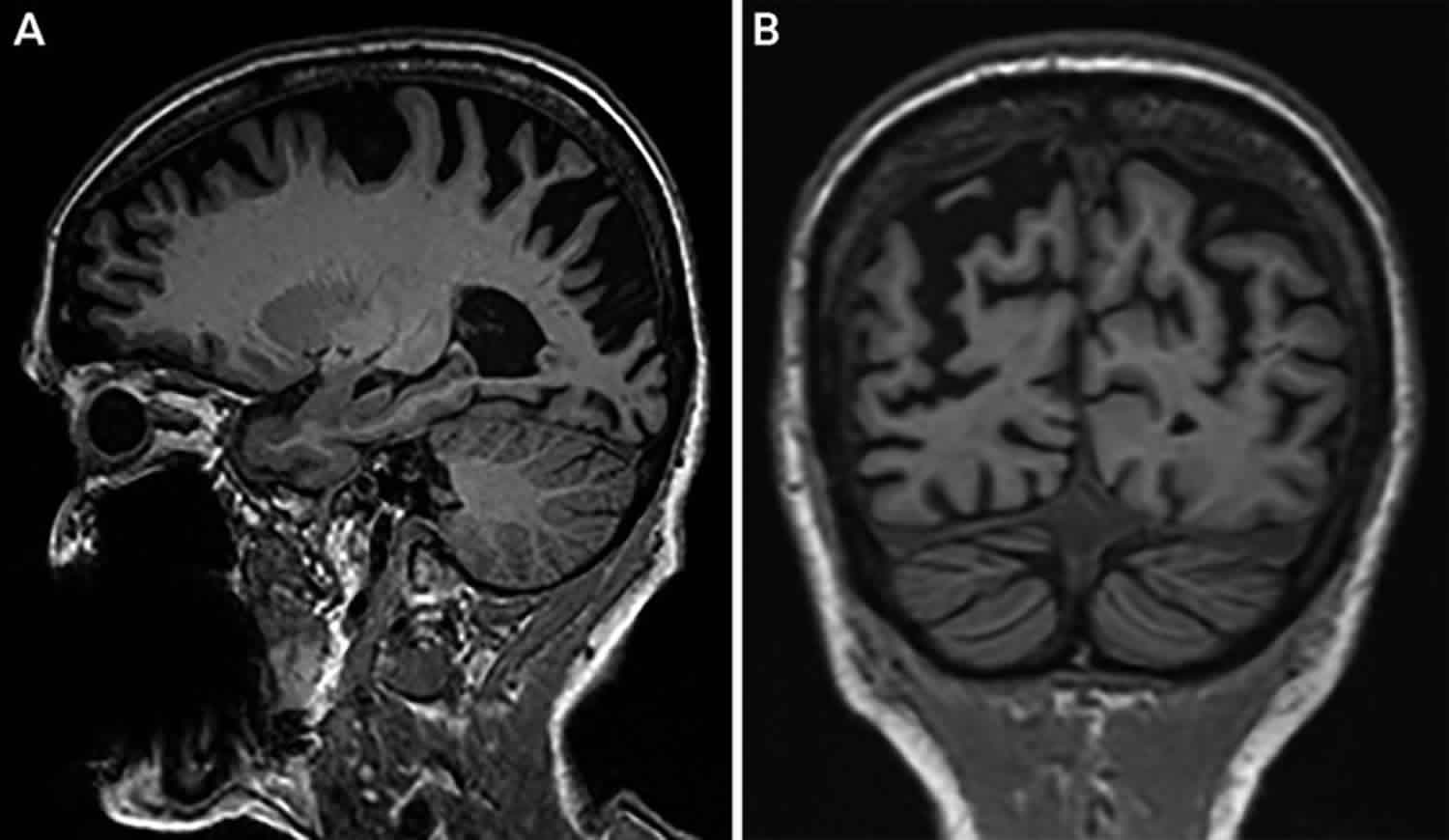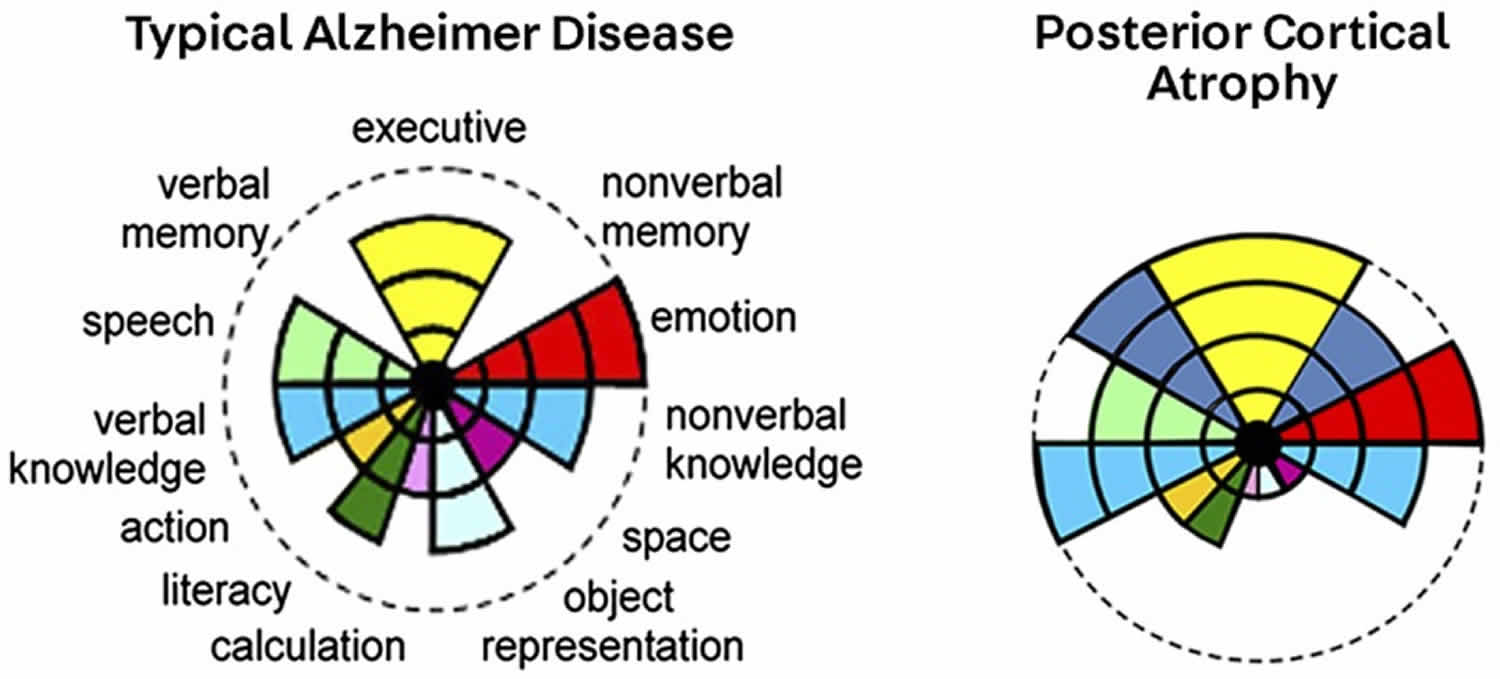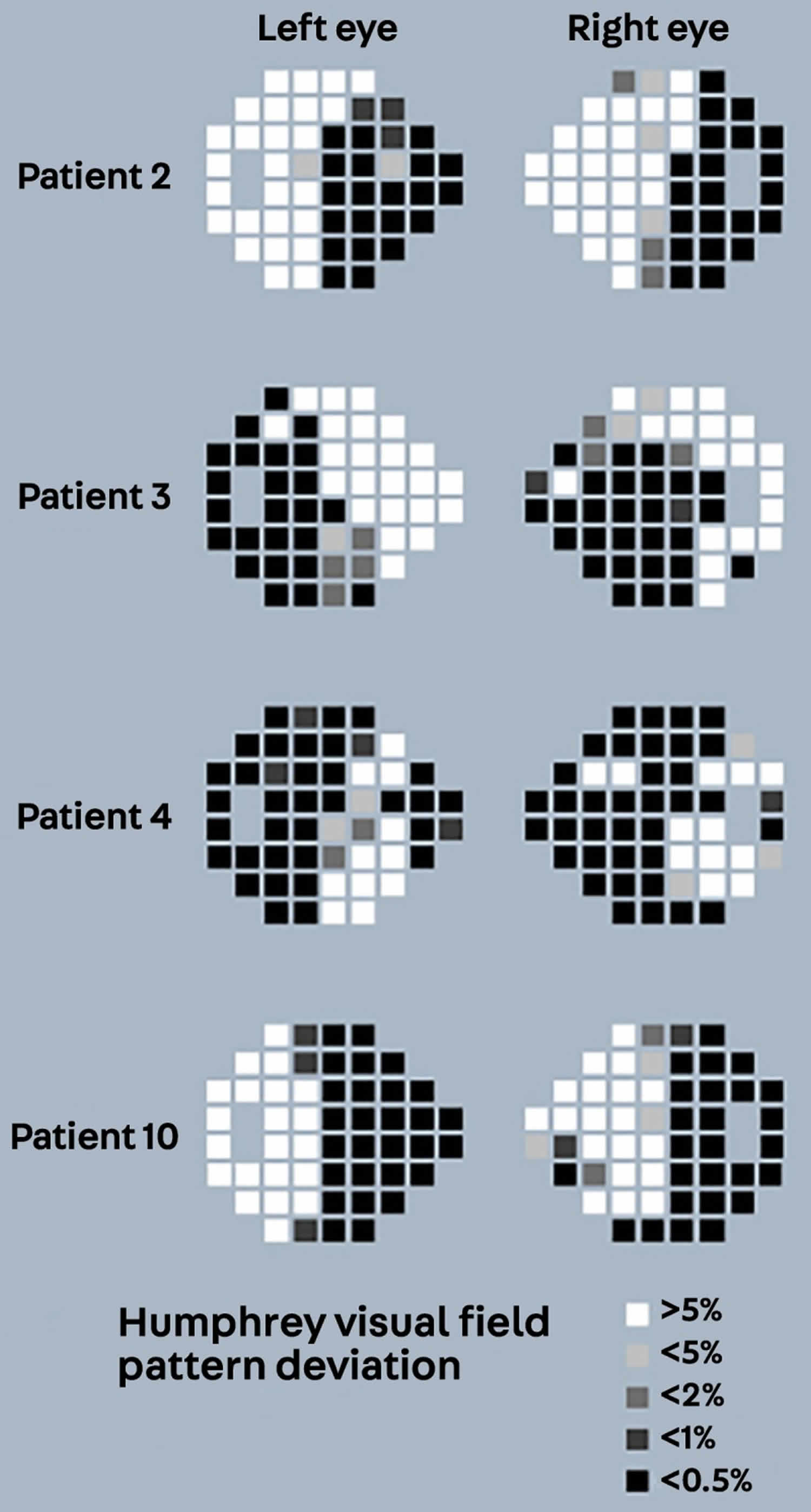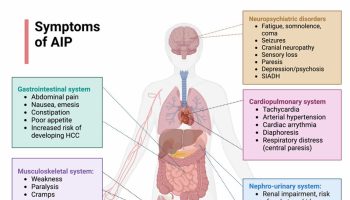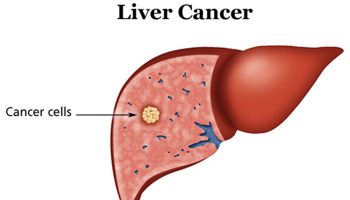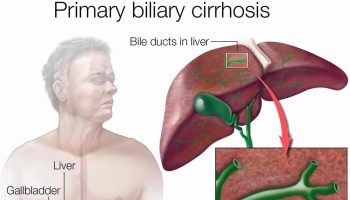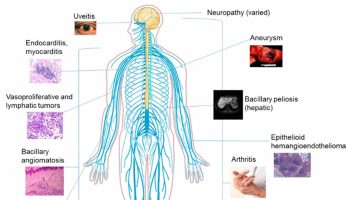Posterior cortical atrophy
Posterior cortical atrophy also called Benson’s syndrome, is a rare neurodegenerative syndrome that primarily affects the brain parietal and occipital lobes that results in gradually declining vision 1. While patients with progressive visual impairment with normal acuity had previously been described, the term posterior cortical atrophy was introduced by Benson and colleagues 2, who described a series of patients with deficits in higher-order visual processing and features consistent with aspects of Gerstmann syndrome (acalculia, left-right disorientation, finger agnosia, and agraphia) and Balint syndrome (ocular motor apraxia, optic ataxia, and simultanagnosia) but with relatively preserved episodic memory until later in the disease. Subsequent case series determined that the most common underlying pathology was Alzheimer disease 3, leading to alternative nomenclature including the visual variant of Alzheimer disease and biparietal Alzheimer disease 4. However, as posterior cortical atrophy can be due to alternative pathologies, including corticobasal degeneration 5, Lewy body dementia and (very rarely) prion disease, the overarching term posterior cortical atrophy is now preferred to describe the syndrome, with contemporary criteria allowing for subdivisions into posterior cortical atrophy-pure, posterior cortical atrophy-plus, and pathologic subtypes depending on the clinical presentation and availability of biomarker evidence of underlying pathology 6. Most cases of Alzheimer’s disease occur in people age 65 or older, whereas the onset of posterior cortical atrophy commonly occurs between ages 50 and 65.
Posterior cortical atrophy may eventually cause your memory and thinking abilities (cognitive skills) to decline.
There is no standard definition of posterior cortical atrophy and no established diagnostic criteria, and it is not possible to know how many people have the condition. Some studies have found that about 5 percent of people diagnosed with Alzheimer’s disease have posterior cortical atrophy. However, because posterior cortical atrophy often goes unrecognized, the true percentage may be as high as 15 percent 7. Researchers and physicians are working to establish a standard definition and diagnostic criteria for posterior cortical atrophy.
Misdiagnosis of posterior cortical atrophy is common, owing to its relative rarity and unusual and variable presentation. Additionally, people with posterior cortical atrophy frequently first seek the opinion of an ophthalmologist who may indicate a normal eye examination by their usual tests. Because the first problems are perceived as eye problems, cortical brain dysfunction initially may not be considered as a cause.
Physicians rely on a combination of neuropsychological tests, blood tests, brain scans and a neurological examination to diagnose the condition and rule out other potential explanations for symptoms. Characteristic features that are sometimes used for diagnosis include gradual onset of visual symptoms (described above) with preservation of normal eye function and preservation of memory. Age of onset between 50 and 65 years is another clue suggesting posterior cortical atrophy. The diagnosis should rule out the possibility that the symptoms were caused by a stroke, tumor or other identifiable condition.
There is an ongoing discussion in the field whether posterior cortical atrophy should be considered a form of Alzheimer’s disease or a distinct disease entity. Brain imaging has shown that the posterior cortex is thinner in people with posterior cortical atrophy than healthy people of the same age. This indicates that the individual has experienced a decrease in brain volume. Furthermore, people with posterior cortical atrophy have degeneration in different parts of the brain than people with typical forms of Alzheimer’s disease, although there is often overlap between the two conditions.
Posterior cortical atrophy can’t be cured, but your doctor can help you manage your condition. Currently there are no treatments for posterior cortical atrophy known to slow or halt its progression. Treatment options include:
- Medications. Your doctor may give you medications to treat symptoms, such as depression or anxiety.
- Physical, occupational or cognitive therapy. These therapies may help you regain or retain skills that are affected by posterior cortical atrophy.
Because posterior cortical atrophy resembles Alzheimer’s disease in some patients, it has been suggested that drugs used to temporarily alleviate brain dysfunction in Alzheimer’s disease may be helpful in posterior cortical atrophy, but this is not proven. Some people with posterior cortical atrophy may benefit from treatment to alleviate symptoms such as depression or anxiety, but the overall benefits and risks of such treatments are not established.
Posterior cortical atrophy key points
- A striking feature of posterior cortical atrophy is that the majority of affected individuals have an unusually early age at disease onset, typically presenting between 50 and 65 years of age.
- Most patients with posterior cortical atrophy have underlying Alzheimer disease.
- The core features of posterior cortical atrophy include visuospatial and perceptual deficits as well as features of Gerstmann syndrome (acalculia, left-right disorientation, finger agnosia, and agraphia), Balint syndrome (ocular motor apraxia, optic ataxia, and simultanagnosia), alexia, and apraxia.
- Patients with posterior cortical atrophy are often diagnosed late or are misdiagnosed as having a primary ocular or psychologically mediated illness.
- Patients with posterior cortical atrophy may have a history of repeated visits to optometrists and ophthalmologists and multiple unsuccessful changes in eyeglasses or surgical procedures in an attempt to correct acuity.
- Over time, difficulties with reading emerge in the vast majority of patients with posterior cortical atrophy.
- Patients with posterior cortical atrophy often become anxious about riding on escalators, particularly when going down; can be cautious when crossing the road because of difficulties in judging the speed of traffic; and can have difficulty with revolving doors.
- Combinations of visual problems and dyspraxia in patients with posterior cortical atrophy have significant functional consequences, including difficulty in getting dressed; cooking; and using cell phones, remote controls, and computers.
- Simultanagnosia (the inability to interpret the entirety of a visual scene) can often be demonstrated by asking an individual to describe a complex picture; rather than describing it in its entirety, individuals with posterior cortical atrophy will often hone in on specific features and fail to see the picture as a whole.
- A particularly striking and very common feature of posterior cortical atrophy is the presence of an apperceptive agnosia.
- Visual disorientation (likely reflecting combinations of simultanagnosia and optic ataxia), when present, is a striking sign in patients with posterior cortical atrophy.
- When performing neuropsychological testing in posterior cortical atrophy, it is important that the testing psychologist is aware of the patient’s difficulties with vision, ensuring that test material is, whenever possible, presented in verbal rather than visual form.
- In the presence of a typical history for posterior cortical atrophy, the absence of marked parietooccipital volume loss should not exclude the diagnosis.
- Fludeoxyglucose positron emission tomography may be extremely valuable in demonstrating hypometabolism within the parietooccipital cortices.
- While amyloid positron emission tomography has a role in confirming the presence or absence of amyloid pathology, it is not useful in distinguishing between Alzheimer disease syndromes.
- Tau positron emission tomography, which is currently only available in a research setting, often shows very striking posterior cortical deposition of tau pathology.
- Posterior cortical atrophy due to Alzheimer disease is a sporadic condition, and routine testing for the autosomal dominant forms of the disease is not usually indicated.
- For most patients with posterior cortical atrophy due to Alzheimer disease, treatment with acetylcholinesterase inhibitors or memantine, as would be standard treatment for Alzheimer disease, is appropriate.
- The mainstay of management of patients with posterior cortical atrophy (as with typical Alzheimer disease) is the provision of practical and psychological support to affected patients and their caregivers.
- Most patients with posterior cortical atrophy will not be fit to drive. Establishing driving safety is of paramount importance.
Posterior cortical atrophy stages
Prodromal/suspected/possible posterior cortical atrophy
This term might be ascribed (in some circumstances, alongside other differential diagnoses) to individuals exhibiting subtle deficits in posterior cortical functions which are too mild or few (<3) to fulfill the core posterior cortical atrophy criteria 6. As only individuals proceeding to a diagnosis of posterior cortical atrophy could reliably be labeled prodromal posterior cortical atrophy, this stage in the evolution of posterior cortical atrophy would most likely be identified retrospectively in longitudinal studies 6. In other situations, alternative labels such as “suspected posterior cortical atrophy” or “possible posterior cortical atrophy” might be preferred. The concept of prodromal posterior cortical atrophy is motivated by the assumption that a proportion of individuals with prodromal Alzheimer’s disease (International Working Group (IWG) criteria; clinical symptoms present but insufficient to affect instrumental activities of daily living) will be in the early clinical stages of posterior cortical atrophy 8. By definition, the clinico-radiological syndrome posterior cortical atrophy cannot be defined at the preclinical asymptomatic at-risk state for Alzheimer’s disease (International Working Group) 9 or stage 1 or 2 preclinical Alzheimer’s disease 10 where cognitive impairment is absent. It is also of note here that some individuals with posterior cortical atrophy may not ever meet National Institute on Aging-Alzheimer’s Association definitions of mild cognitive impairment (MCI), owing to the impact of even subtle posterior cortical dysfunction on everyday functional tasks. Mild cognitive impairment criteria state “These cognitive changes should be sufficiently mild that there is no evidence of a significant impairment in social or occupational functioning” and “it must be recognized that atypical clinical presentations of Alzheimer’s disease may arise, such as the visual variant of Alzheimer’s disease (involving posterior cortical atrophy) or the language variant (sometimes called logopenic aphasia), and these clinical profiles are also consistent with mild cognitive impairment due to Alzheimer’s disease”. However, mild posterior cortical dysfunction can have a profound impact on certain everyday functions (e.g., driving). Although comparing levels of “severity” across different cognitive domains is difficult, it may be that the relative impact of mild cognitive deficits on everyday function may vary between typical and atypical Alzheimer’s disease phenotypes.
Posterior cortical atrophy
The second stage of progression might simply be labeled posterior cortical atrophy and could be entirely consistent with the definition of posterior cortical atrophy provided previously in classification level 1, namely fulfillment of the clinical, cognitive, neuroimaging, and exclusion criteria listed in the posterior cortical atrophy 2017 international consortium diagnostic criteria listed below 6. The only point of expansion is that, just as prodromal posterior cortical atrophy would not necessarily equate to mild cognitive impairment, so posterior cortical atrophy would not necessarily equate to dementia. Many patients with posterior cortical atrophy for a time only show impairment in one of the five listed domains in McKhann et al. 11 (i.e., evidence of visuospatial but not memory, reasoning, language, or personality/behavior deficits). At this stage, such cases may not fulfill the various rules for formal classification as dementia, and therefore diagnosis for which dementia is a prerequisite, namely probable Alzheimer’s disease dementia, possible Alzheimer’s disease dementia, or possible Alzheimer’s disease dementia with evidence of the Alzheimer’s disease pathophysiological process.
Advanced posterior cortical atrophy
This third provisional staging term could be used to describe individuals who have or would have previously met criteria for posterior cortical atrophy but in whom disease progression has led to impairments in other aspects of cognitive function (i.e., episodic memory, language, executive functions, behavior, and personality). Advanced posterior cortical atrophy might most typically be observed in individuals in whom either (1) visual ± nonvisual posterior dysfunction with relative preservation of these other cognitive skills was the primary complaint, but memory, language, executive, and/or behavior/personality deficits have now progressed and are also significantly impaired or (2) impairments in visual ± nonvisual posterior functions and one or more of these other cognitive skills were evident at presentation but the clinical history and/or other evidence indicate that posterior cortical deficits were the primary complaint (i.e., the patient did not present/was not assessed at the earlier stage when posterior cortical atrophy could have been diagnosed). The term advanced posterior cortical atrophy might be applicable to a number of posterior cortical atrophy patients described in the existing literature. For example, in a study of posterior cortical atrophy basic visual function 12, all 21 patients fulfilled Mendez et al. 13 and Tang-Wai et al. 14 criteria and had current or previous evidence on formal neuropsychological assessment of impaired visual function with relatively preserved (normal range) scores on at least one test of episodic memory. However, at the time of the experimental study, 5/21 (24%) had progressed to a point where episodic memory test scores fell below the normal range, with 12/21 (57%) showing deficits on naming from description (executive functions, behavior, and personality were not assessed formally). The advanced posterior cortical atrophy concept is particularly relevant to the characterization of research participants, prognostic and longitudinal studies, clinical management and care planning, and for educating to patients and their caregivers.
Posterior cortical atrophy causes
Similar to Alzheimer’s disease, the causes of posterior cortical atrophy are unknown, and no obvious genetic mutations have been shown to be linked to the condition. It is also not known if the risk factors for Alzheimer’s disease are also risk factors for posterior cortical atrophy.
Most patients with posterior cortical atrophy have underlying Alzheimer’s disease 3, although cases of posterior cortical atrophy can be associated with Lewy body pathology 3 (either in isolation or, commonly, in combination with Alzheimer’s disease) and, very rarely, with subcortical gliosis or prion disease 15. On postmortem examination, most cases will naturally have end-stage disease, but even at late stages, differences in the distribution of neurofibrillary tangles compared to patients with typical Alzheimer’s disease have been noted, with particular involvement of primary visual cortices and visual association areas 16. Conversely, most studies have not found major differences in amyloid burden across the cortex compared to other forms of Alzheimer’s disease 17.
Posterior cortical atrophy symptoms
The symptoms of posterior cortical atrophy can vary from one person to the next and can change as the condition progresses. The most common symptoms are consistent with damage to the posterior cortex of the brain, an area responsible for processing visual information. Consistent with this neurological damage are slowly developing difficulties with visual tasks such as reading a line of text, judging distances, distinguishing between moving objects and stationary objects, inability to perceive more than one object at a time, difficulties recognizing objects and familiar faces, disorientation, and difficulty maneuvering, identifying, and using tools or common objects. Some patients experience hallucinations. Other symptoms can include difficulty performing mathematical calculations or spelling, and many people with posterior cortical atrophy experience anxiety, possibly because they know something is wrong. In the early stages of posterior cortical atrophy, most people do not have markedly reduced memory, but memory can be affected in later stages.
The core features of posterior cortical atrophy include visuospatial and perceptual deficits as well as features of Gerstmann syndrome (acalculia, left-right disorientation, finger agnosia, and agraphia), Balint syndrome (ocular motor apraxia, optic ataxia, and simultanagnosia), alexia, and apraxia 1. In contrast to typical Alzheimer’s disease, episodic memory is relatively preserved at onset; compared with frontotemporal dementia, aside from the common feature of anxiety 18, personality and behavior are not usually affected in posterior cortical atrophy and insight is preserved.
Atypical presentations
Considerable debate has existed as to whether the presence of early visual symptoms is essential for a diagnosis of posterior cortical atrophy 18 or whether presentations with other parietal features (eg, early prominent dyspraxia) with subsequent emergence of more typical visual features should still be classified under the posterior cortical atrophy umbrella. This has implications for diagnostic criteria, as patients with early motor features can overlap with other conditions, such as corticobasal syndrome, an issue that is now addressed in the most recent consensus criteria 6. Some patients with a pure posterior cortical atrophy phenotype may have corticobasal degeneration or Lewy body pathology rather than Alzheimer’s disease. However, the presence of features typical for these conditions (eg, alien limb phenomena for corticobasal degeneration or early hallucinations, rapid eye movement [REM] sleep behavior disorder, or parkinsonism for dementia with Lewy bodies) may provide evidence for these alternative pathologies. While the Heidenhain variant of Creutzfeldt-Jakob disease (which presents with early visual impairment) can, in theory, be mistaken for posterior cortical atrophy, other clinical features, including the (usual) rapidity of the presentation and the nature of the visual disturbance (which, in prion disease, is often associated with frightening visual distortions), usually mean this is not a major diagnostic challenge. In rare overlap cases, the MRI features and evidence of diffusion changes, in particular in Creutzfeldt-Jakob disease, are particularly valuable 15.
Posterior cortical atrophy diagnosis
There are no standard diagnostic criteria for posterior cortical atrophy, although diagnostic criteria are being developed. To diagnose posterior cortical atrophy, your doctor will review your medical history and symptoms, including vision difficulties, and conduct a physical examination and a neurological examination.
Your doctor may order several tests to help diagnose posterior cortical atrophy and exclude other conditions that may cause similar symptoms, including:
- Neurologic examination. In patients with typical posterior cortical atrophy due to Alzheimer’s disease, aside from demonstrating the higher-order visual signs and dyspraxia described above, the neurologic examination is typically unremarkable, although a proportion of individuals will have mild motor signs or myoclonus 19. Specific features that should be assessed include the presence of significant parkinsonism, which may reflect underlying Lewy body pathology, and very asymmetric motor features (dystonia, dyspraxia, myoclonus, and alien limb), which might reflect a corticobasal syndrome. Patients will not typically have upper motor neuron signs or features of amyotrophy. Watching the patient walk may be very informative, as mild balance problems are not infrequently encountered by patients with posterior cortical atrophy, and the functional consequences of higher-order visual problems may be demonstrated if patients bump into walls or doorframes while walking.
- Mental status and neuropsychological tests. Your doctor will ask you questions and conduct tests to assess your cognitive skills. You may have psychiatric assessments to test for depression or other mental illnesses. Detailed neuropsychological assessment provides objective evidence for the cognitive domains that are both affected and preserved in posterior cortical atrophy, with implications for diagnosis and potentially for management. A standard neuropsychometric battery can be employed in patients with posterior cortical atrophy but with a few caveats. It is important that the testing psychologist is aware of the individual’s difficulties with vision, ensuring that test material is, whenever possible, presented in verbal rather than visual form (eg, nominal skills may be better determined by naming to description than to a picture). Similarly, assessment of premorbid IQ based on reading words from the National Adult Reading Test 20 may or may not be reliable depending on the extent of visual impairment. Patients with posterior cortical atrophy typically show a marked discrepancy between performance IQ (low) and verbal IQ and deficits in parietal tasks with preservation of memory and executive tests, provided that imagery and other deficits are taken into account (eg, recognition memory performance may remain preserved when recall appears impaired) (see Figure 1 below). On this basis, neuropsychological research criteria for posterior cortical atrophy have been described that require, for example, evidence for impairments (performance at less than the 5th percentile) on at least two out of four parietal tests (object perception, space perception, calculation, spelling) with evidence of preservation (greater than the 5th percentile) on a recognition memory test, in addition to fulfilling clinical criteria 21.
- Blood tests. Your blood may be tested for vitamin deficiency, thyroid disorders and other conditions that may be causing your symptoms.
- Ophthalmology examination. Your doctor will conduct a vision test to determine whether another condition is causing your vision symptoms. While formal ocular assessment performed carefully can demonstrate normal acuity and fundi, visual field testing in posterior cortical atrophy often reveals hemifield impairments or constriction 22, including unusual and variable field deficits not confirming to classic cortical lesions 23, which can be mistaken as being nonorganic (see Figure 2).
- Cerebrospinal fluid (CSF) tests. In keeping with posterior cortical atrophy usually being underpinned by Alzheimer’s disease, CSF amyloid-β (Aβ)1-42 is depressed and concentrations of total tau and phosphorylated tau are increased 24. However, while levels of Aβ1-42 depression are similar to other forms of Alzheimer’s disease, some evidence indicates that levels of total tau and phosphorylated tau are not as elevated as in typical Alzheimer’s disease, perhaps relating to either different intensities or extent of neurodegeneration 25. In practice, therefore, clinicians should be aware that tau to amyloid-β (Aβ)1-42 ratios may be less elevated in posterior cortical atrophy than in typical Alzheimer’s disease. As with other forms of Alzheimer’s disease, the total cell count and protein are not elevated; if these are seen, other diagnoses should be considered.
- Genetic testing. Posterior cortical atrophy due to Alzheimer’s disease is a sporadic condition, and routine testing for the autosomal dominant forms of the disease is not usually indicated. Testing for APOE genotyping is not recommended as part of the diagnostic workup for any form of Alzheimer’s disease, and this is particularly the case for posterior cortical atrophy, in which evidence indicates that possession of an APOE ε4 allele may be less frequent than in typical cases 26.
- Magnetic resonance imaging (MRI). An MRI machine uses powerful radio waves and a magnetic field to create a 3-D view of your brain. In this test, your doctor can view abnormalities in your brain that may be causing your symptoms.
- Fludeoxyglucose positron emission tomography (FDG-PET) or single-photon emission computerized tomography (SPECT). In these tests, a doctor injects a small amount of radioactive material and places emission detectors on your brain. PET provides visual images of brain activity. SPECT measures blood flow to various regions of your brain.
- As patients with posterior cortical atrophy, by definition, have atypical disease and almost all present with early-onset dementia, most will fall within appropriate use criteria for amyloid PET imaging 27. Where available, amyloid PET can provide invaluable evidence for underlying Alzheimer’s disease. However, in contrast to the striking focality both of the symptom and structural imaging changes, amyloid deposition is usually seen across the cortex, with amyloid PET scans from patients with posterior cortical atrophy often being indistinguishable from patients with more typical forms of Alzheimer’s disease 28. Thus, while amyloid PET has a role in defining pathology, it is not useful in defining Alzheimer’s disease syndromes. By contrast, tau PET scanning, which is currently only available in a research setting, often shows very striking posterior cortical deposition of tau pathology in posterior cortical atrophy 29.
Figure 1. Mental status and neuropsychological test results for posterior cortical atrophy
Footnote: Pattern of cognitive impairment in typical Alzheimer disease (A) and posterior cortical atrophy (B). Increasing impairment in a cognitive domain is represented by retreat of the color in its segment toward the center of the circle. Thus, verbal and nonverbal memory are profoundly affected in panel A but relatively preserved in panel B, while profound posterior cortical impairment is seen in panel B.
[Source 24 ]Figure 2. Visual fields in posterior cortical atrophy
Footnote: In patient 2 and patient 10, visual field deficits are principally limited to a hemifield; in patient 3 and patient 4, both hemifields are affected to some extent.
[Source 24 ]Medical history
Because of its relative rarity, posterior cortical atrophy is often diagnosed late, and by the time patients present to neurologists, symptoms will often have been present for many months or years 24. Very early symptoms can be rather nebulous: patients often describe nonspecific anxiety and a sense that something is wrong, before more concrete problems (usually centered on vision) become apparent. Patients may have a history of repeated visits to optometrists or ophthalmologists and multiple unsuccessful changes in eyeglasses or surgical procedures in an attempt to correct acuity. Patients can often express themselves very clearly and so are not considered as having a “dementia” or are diagnosed as having had a stroke before progressive problems emerge. Patients often describe causing minor damage to their cars because of problems judging distances while parking. Problems reading analog clocks and digitized pixelated signs are common early features.
Over time, difficulties with reading emerge in the vast majority of patients 30. Patients typically get lost while reading text, particularly when moving from line to line or when there is too much competing textual information (so-called crowding) 31 or may describe a sense that words are moving or slipping off the page 32. Most patients with posterior cortical atrophy will be unable to read within a few years of symptom onset. Occasionally, patients may describe abnormalities with color vision, describing washes of color or prolonged afterimages 33. Patients may describe difficulties in finding items in front of them, particularly in more cluttered environments (simultanagnosia, discussed later in this article) or a sensation that items are moving. Patients often become anxious about riding on escalators, particularly when going down; can be cautious when crossing the road because of difficulties in judging the speed of traffic; and can have difficulty with revolving doors or identifying steps or slopes when walking on patterned carpets. Featureless environments, such as white-tiled bathrooms and shiny surfaces, can be particularly disorienting. Patents will often develop impaired facial recognition (prosopagnosia) 3, often while still being able to identify people by voice. Some individuals describe unusual symptoms that can be misconstrued as nonorganic, including finding it easier to read small rather than large text, and difficulties in identifying static objects while being able to track items in motion. An extreme example of this phenomenon is rare patients who can play sports such as tennis or badminton but are unable to locate the ball or shuttlecock when it is on the floor.
Outside of the visual domain, common symptoms are those attributable to impairments of dominant parietal lobe function 3, including difficulty with calculation and handling money or spelling. Dyspraxia (acquired deficits in performing complex motor programs) is very common 34. Combinations of visual problems and dyspraxia have significant functional consequences, including difficulty in getting dressed (eg, problems buttoning or zipping, tying neckties, or finding the sleeves of coats or putting on clothes backward); cooking; and using cell phones, remote controls, and computers.
Episodic memory and executive impairments are typically not observed in the early stages, although patients may fail certain memory and executive tasks owing to visual, imagery, and other deficits, but emerge as the disease progresses. Language impairment is typically considered a late feature of this disorder, although evidence exists that early anomia is relatively common when specifically looked for 35. This may reflect that while in their purest forms, the different established symptoms of Alzheimer’s disease dementia can easily be distinguished, in practice and as expected for a neurodegenerative process that spreads over time, a degree of overlap exists between different syndromic variants; this becomes increasingly apparent as the disease advances.
Aside from dyspraxia, a number of other motor features can be seen in posterior cortical atrophy, including limb rigidity, myoclonus, and tremor 19. While these can reflect underlying pathologies other than Alzheimer’s disease (eg, corticobasal degeneration16 or, when parkinsonism is present, dementia with Lewy bodies), these can also be seen in posterior cortical atrophy underpinned by Alzheimer pathology 19.
As posterior cortical atrophy progresses, symptoms inevitably worsen. The majority of patients will become functionally blind, which has major implications for the level of care that is required and can be the cause of considerable distress to the individual, who will often have good insight into his/her problems. Being unable to read or use other communication devices and becoming increasingly dependent on others often leads individuals to feel disempowered and depressed 36. Patients who already have severe visual problems will become at high risk of falls as other cognitive and motor problems emerge. In its later stages, posterior cortical atrophy is often indistinguishable from advanced typical Alzheimer’s disease.
Posterior cortical atrophy diagnostic criteria
Posterior cortical atrophy 2017 international consortium diagnostic criteria 6:
NOTE: Clinical, cognitive, and neuroimaging features are rank ordered in terms of (decreasing) frequency at first assessment as rated by online survey participants
Core features of the Posterior Cortical Atrophy Clinicoradiologic Syndrome
- Clinical features:
- Insidious onset
- Gradual progression
- Prominent early disturbance of visual ± other posterior cognitive functions
- Cognitive features:
- At least three of the following must be present as early or presenting features ± evidence of their impact on activities of daily living:
- Space perception deficit
- Simultanagnosia
- Object perception deficit
- Constructional dyspraxia
- Environmental agnosia
- Oculomotor apraxia
- Dressing apraxia
- Optic ataxia
- Alexia
- Left/right disorientation
- Acalculia
- Limb apraxia (not limb-kinetic)
- Apperceptive prosopagnosia
- Agraphia
- Homonymous visual field defect
- Finger agnosia
- All of the following must be evident:
- Relatively spared anterograde memory function
- Relatively spared speech and nonvisual language functions
- Relatively spared executive functions
- Relatively spared behavior and personality
- At least three of the following must be present as early or presenting features ± evidence of their impact on activities of daily living:
- Neuroimaging:
- Predominant occipito-parietal or occipito-temporal atrophy/hypometabolism/hypoperfusion on MRI/fludeoxyglucose positron emission tomography (FDG-PET)/SPECT
- Exclusion criteria:
- Evidence of a brain tumor or other mass lesion sufficient to explain the symptoms
- Evidence of significant vascular disease including focal stroke sufficient to explain the symptoms
- Evidence of afferent visual cause (e.g., optic nerve, chiasm, or tract)
- Evidence of other identifiable causes for cognitive impairment (e.g., renal failure)
This classification aims also to be complementary to the diagnostic classifications for Alzheimer’s disease, which increasingly recognize posterior cortical atrophy as an atypical form of Alzheimer’s disease 37, providing a framework that can be adapted for different purposes. Thus, for providing appropriate support to individuals, the underlying pathology may be less relevant than the clinical picture, while for research studies aiming to determine the causes of phenotypic heterogeneity, it may be important to classify patients on the basis of both syndrome and pathology.
Posterior cortical atrophy treatment
While much of the management of posterior cortical atrophy is similar to that for typical Alzheimer’s disease, the dominant visual problems encountered by most patients mean that some specific issues require consideration.
Medical treatment
Pharmacologic treatments for posterior cortical atrophy should be directed to the underlying pathologic substrate. For most patients with posterior cortical atrophy due to Alzheimer’s disease, treatment with acetylcholinesterase inhibitors or memantine, as would be standard treatment for Alzheimer’s disease, is appropriate. While pivotal clinical trials for the licensing of these drugs focused on typical amnestic Alzheimer’s disease, individual reports have shown that patients with posterior cortical atrophy also benefit 38.
Progressive visual impairment and increasing dependence emerging in the face of intact insight often results in significant anxiety, depression, and feelings of guilt 36. While no controlled trials have been conducted, anecdotal evidence suggests that patients may benefit from counseling and other psychological approaches and from standard pharmacologic treatments for mood and anxiety (eg, with selective serotonin reuptake inhibitors [SSRIs]). When myoclonus emerges and becomes problematic, small doses of levetiracetam may be helpful.
Nonpharmacologic treatments
In the absence of disease-modifying therapies, the mainstay of management of patients with posterior cortical atrophy (as with typical Alzheimer’s disease) is the provision of practical and psychological support to affected patients and their caregivers. Even in the absence of specific therapies, an accurate diagnosis is a vital staging point in an individual patient’s journey, not least as diagnosis is often delayed and symptoms overlooked, misinterpreted, or ignored for many years. Most patients will have stopped, or been stopped from, driving by the time a diagnosis is made, but determining whether patients with posterior cortical atrophy are fit to drive is clearly of paramount importance.
The major functional problems in posterior cortical atrophy involve everyday skills and self-care 39. Loss of ability to read may be helped with the provision of audio books. Technologic advances such as voice recognition on smartphones, computers, and mobile devices can be invaluable in maintaining an individual’s independence. Specific apps have been developed to help the reading problems in posterior cortical atrophy, moving text into the individual’s central vision at an appropriate speed and thus avoiding the need to make saccadic movements from word to word 40. When out of the home, the provision of a white cane is a simple measure that ensures that others are aware of the patient’s potential impairments. Within the house, measures to help with identification of objects and navigation (eg, by putting colored tape on doorframes) or labeling specific items may be helpful. As the disease progresses, home adaptions to minimize stair use and help with bathing and washing may be required. Involving a multidisciplinary team with occupational and physical therapy is often invaluable. Practical tips for patients with posterior cortical atrophy and their families are summarized below. The relative rarity of posterior cortical atrophy can lead to isolation. The development of specific support groups for these individuals locally and, increasingly, nationally and internationally can provide a valuable source of support to individuals and their families.
Living with posterior cortical atrophy
Home Safety Tips and Recommendations for patients with posterior cortical atrophy and other dementias with visual dysfunction 41:
- Simplify the environment
- Remove clutter and objects no longer in use; keep pathways clear.
- Remove unsafe furniture and accents: i.e. low height stools, chairs or tables.
- Options to decrease the potential falls risk from scatter rugs and door mats:
- Remove unsafe scatter rugs/mats
- Install non-slip under-padding
- Replace with rugs/mats with a rubber backing
- Secure all edges with double sided carpet tape (not for outdoor use)
- Relocate and secure trailing cords that are in high traffic areas.
- Ensure adequate lighting: use night lights, install extra lights fixtures.
- Leave lights on prior to nightfall.
- Diffuse bright light areas. Reduce glare by covering windows with binds, shades or sheer curtains to block direct bright sunlight. Avoid using bare light bulbs without shades.
- Obtain a door alarm and /or safety lock.
- Place stickers on large glass windows or large glass doors to prevent people from bumping or walking into to them.
- Increase contrast
- Label room doors; use yellow paper with black writing.
- Paint doorframes and light switch plates in a contrasting colour to the wall.
- Contrasting color dot to mark the number/button to release automatic door.
- Contrasting color strips (paint or tape) or tactile cue at top and bottom of stairs, as well as on the edge of each individual step (both inside and outside).
- Use contrasting coloured adhesive strips to mark pathways to important areas –bathroom, kitchen, living room, laundry.
- Kitchen
- Mark burners and stove dials with contrasting colour to make it easier to identify and to know when elements are hot.
- Dials at the front of the stove are more desirable then dials at the back of the stove in order to avoid reaching over the elements.
- Mark frequently used settings on the oven or other dials (e.g. 350 degrees or normal cycle for the dishwasher) with a bumper dot or contrasting tactile marker.
- Supervise the person while using the stove, and ifnecessary, disconnect the stove and other appliances when they are home alone.
- Mark the 1-minute button on the microwave with a contrasting color bumper dot, tactile marker, bright tape or nail polish.
- Place cleaning supplies away from food supplies (very important)
- Dispose of hazardous substances that are no longer needed and store other potentially hazardous substances in secured storage (locked cupboard, childproof door locks).
- Keep cupboard doors and drawers closed at all times and ensure everything is put away in its proper place.
- Problem-solve an appropriate organizational structure to the kitchen; consider having one designated area of counter space for preferred and usual foods. Trial placing frequently used items on a contrasting mat or tray, located in the same place every day. This is in an attempt to increase independence in finding items and participating in meal preparation.
- Store/relocate frequently used items at accessible and visible level.
- Keep counters clear and minimize clutter.
- Consider using appliances with automatic shut-off; i.e., kettle.
- Other items to optimize safety, independence and participation in the kitchen:
- Elbow-length oven mitts to ensure maximum protection.
- Knife guard aid to enable safe use and pressure when cutting.
- Cutting board with a black side and a white side to enhance contrast while cutting.
- Gooseneck lamp above the cutting area may also assist with vision.
- Large print timer.
- Liquid measure tool to assist in pouring liquids and avoid spills
- Re-label jars and canned goods using a thick black marker, white recipe card, single words, and elastic bands.
- Penfriend Audio Labeler or similar
- Eating
- Use bright colored contrasting dishes and ensure they are all one solid color (no patterns and no ridged edges).
- Use a dark solid-colored placemat if using light-colored plates and use a light solid-colored placemat if using dark plates.
- Light-colored food will be easier to see on a solid dark-colored dish and dark food on a light dish.
- Avoid patterned table clothes.
- Maintain a strict pattern for mealtime set-up. For example, always place the same utensils, drinking glass and condiments in the same place for every meal.
- Avoid cluttering the eating area and only have necessary items within reach.
- Use verbal directions as reminders of where items are located; i.e., “your glass is on your right,” and “salt and pepper is on your left.”
- Use plate guards during meal times
- Bedroom
- Use bright, contrasting color fitted sheet, top sheet, pillow cases. Each should be a different colour to optimize identification and orientation to and within the bed.
- Place a bright colored mat on nightstand to contrast against items placed on it.
- Dressing:
- Label drawers and shelves with high contrast wording or pictures.
- Remove clothes that are no longer being used; including permanent removal of clothes no longer worn and temporary storage of out-of-season clothing.
- Simplify and organize arrangement of clothing; for example, group similar items together, one drawer for shirts andanother drawer for pants.
- Lay out clothing for the day
- Minimize clothing requiring buttons and zippers and replace with elastic waists, pull-over/on, and loose clothing.
- Pin socks together when placing them in the laundry so they will stay matched
- Bathroom
- Reduce clutter on bathroom floor, countertop, in drawers and cabinets.
- Use high-contrast non-slip bath mat and install high-contrast grab bars in the shower or bathtub; use contrasting tactile strip on existing grab bars to differentiate from tub or towel bar.
- Pick up bathmat after each use and store appropriately to prevent falls.
- If there is noted difficulty accurately locating the toilet you may consider obtaining a toilet seat in a contrasting bright color. Also consider obtaining a raised toilet seat with arms and the tape arms with a bright color in contrast against the toilet seat.
- Tape toilet-flushing handle in a contrasting bright color.
- Label important areas in the bathroom: toilet, sink, bathroom door (yellow paper with black writing).
- Tape sink faucet handles with bright color tape (use primary color such as red, green, blue) to distinguish handle from the rest of the sink.
- Keep soap in a bright container (i.e., red) with contrasting color soap (i.e, white).
- Use sign as reminder to wash hands, flush toilet, brush teeth etc.
- Keep frequently used items (toothbrush, paste) in small shallow basket or on a mat to contrast items against the counter.
- Use toothpaste that contrasts in color to the toothbrush and bristles: i.e. red toothpaste on white brush and bristles.
- Cover mirrors if necessary: often people with vision problems may not be able to recognize the item as a mirror.
- Personal care
- Nails: Ensurenail care is done by aprofessional. Can be provided in-home.
- Footwear: Ensure appropriate footwear is used: flat, non-slip sole, enclosed toe and heel, Velcro fasteners.
- Medication routine
- Supervision of medication routine is usually recommended.
- Store medications in a secure place.
- Remove and properly dispose of medications that are no longer needed or have expired.
- Inquire whether the medication routine can be simplified (i.e., to once-a-day instead of three times a day).
- Other ways to simplify a meds routine: Pre-filled blister packs; dossette; list of current medications; medication schedule; medication alarms/reminders
- Stairs
- Ensure adequate lighting on the stairs; with switches at both the top and bottom.oInstall secure railings on at least one if not both sides.
- Install railing extensions beyond the top and bottom of the stairs.
- Remove or replace unsafe flooring with a non-slip surface.
- Contrasting colored tape or paint on the edge of each step.
- Contrasting colored tape or paint and/or tactile strip at the top and bottom of the stairs.
- Progression:
- Safety gate to prevent use of stairs
- Arrange living area on one level.
- Communication and scheduling
- Use a phone with large print and high contrast numbers, as well as one-touch programmable numbers.
- Program emergency and frequently used numbers to the one-touch programmable numbers and add tactile markers to increase ease of identification.
- Set up a “memory center” with the phone, keys, note pad, whiteboard with large writing area and black marker.
- Include a paper, pen/pencil and task lamp beside the phone for messages.
- Place telephone on bright contrasting colour mat.
- Use contrasting coloured tape to outline phone cradle.
- If possible, utilize a service that requires voice activation for phone dialling.
- Use talking watches or clocks to indicate the time and appointments.
Posterior cortical atrophy life expectancy
Prognosis is poor as posterior cortical atrophy is progressive disorder. Life expectancy after posterior cortical atrophy diagnosis is thought to be similar (8-12 years) to individuals affected with Alzheimer’s disease 42.
- Crutch SJ, Lehmann M, Schott JM, et al. Posterior cortical atrophy. Lancet Neurol 2012;11(2):170–178. doi:10.1016/S1474-4422(11)70289-7[↩][↩]
- Benson DF, Davis RJ, Snyder BD. Posterior cortical atrophy. Arch Neurol 1988;45(7):789–793. doi:10.1001/archneur.1988.00520310107024[↩]
- Tang-Wai DF, Graff-Radford NR, Boeve BF, et al. Clinical, genetic, and neuropathologic characteristics of posterior cortical atrophy. Neurology 2004;63(7):1168–1174. doi:10.1212/01.WNL.0000140289.18472.15[↩][↩][↩][↩][↩]
- Galton CJ, Patterson K, Xuereb JH, Hodges JR. Atypical and typical presentations of Alzheimer’s disease: a clinical, neuropsychological, neuroimaging and pathological study of 13 cases. Brain 2000;123(pt 3):484–498. doi:10.1093/brain/123.3.484[↩]
- Tang-Wai DF, Josephs KA, Boeve BF, et al. Pathologically confirmed corticobasal degeneration presenting with visuospatial dysfunction. Neurology 2003;61(8):1134–1135. doi:10.1212/01.WNL.0000086814.35352.B3[↩]
- Crutch SJ, Schott JM, Rabinovici GD, et al. Consensus classification of posterior cortical atrophy. Alzheimers Dement. 2017;13(8):870-884. doi:10.1016/j.jalz.2017.01.014 https://www.ncbi.nlm.nih.gov/pmc/articles/PMC5788455[↩][↩][↩][↩][↩][↩]
- Posterior Cortical Atrophy. https://www.alz.org/alzheimers-dementia/what-is-dementia/types-of-dementia/posterior-cortical-atrophy[↩]
- Dubois B, Feldman HH, Jacova C, DeKosky ST, Barberger-Gateau P, Cummings J, et al. Research criteria for the diagnosis of Alzheimer’s disease: revising the NINCDS–ADRDA criteria. Lancet Neurol. 2007;6:734–46.[↩]
- Dubois B, Feldman HH, Jacova C, Cummings JL, DeKosky ST, Barberger-Gateau P, et al. Revising the definition of Alzheimer’s disease: a new lexicon. Lancet Neurol. 2010;9:1118–27.[↩]
- Sperling RA, Aisen PS, Beckett LA, Bennett DA, Craft S, Fagan AM, et al. Toward defining the preclinical stages of Alzheimer’s disease: Recommendations from the National Institute on Aging-Alzheimer’s Association workgroups on diagnostic guidelines for Alzheimer’s disease. Alzheimers Dement. 2011;7:280–92.[↩]
- McKhann GM, Knopman DS, Chertkow H, Hyman BT, Jack CR, Kawas CH, et al. The diagnosis of dementia due to Alzheimer’s disease: recommendations from the National Institute on Aging-Alzheimer’s Association workgroups on diagnostic guidelines for Alzheimer’s disease. Alzheimers Dement. 2011;7:263–9.[↩]
- Lehmann M, Barnes J, Ridgway GR, Wattam-Bell J, Warrington EK, Fox NC, et al. Basic visual function and cortical thickness patterns in posterior cortical atrophy. Cereb Cortex. 2011;21:2122–32.[↩]
- Mendez MF, Ghajarania M, Perryman KM. Posterior cortical atrophy: clinical characteristics and differences compared to Alzheimer’s disease. Dement Geriatr Cogn Disord. 2002;14:33–40.[↩]
- Tang-Wai DF, Graff-Radford N, Boeve B, Dickson D, Parisi J, Crook R, et al. Clinical, genetic, and neuropathologic characteristics of posterior cortical atrophy. Neurology. 2004;63:1168–74.[↩]
- Townley RA, Dawson ET, Drubach DA. Heterozygous genotype at codon 129 correlates with prolonged disease course in Heidenhain variant sporadic CJD: case report. Neurocase 2018;24(1):54–58. doi:10.1080/13554794.2018.1439067[↩][↩]
- Hof PR, Vogt BA, Bouras C, Morrison JH. Atypical form of Alzheimer’s disease with prominent posterior cortical atrophy: a review of lesion distribution and circuit disconnection in cortical visual pathways. Vision Res 1997;37(24):3609–3625. doi:10.1016/S0042-6989(96)00240-4[↩]
- Renner JA, Burns JM, Hou CE, et al. Progressive posterior cortical dysfunction: a clinicopathologic series. Neurology 2004;63(7):1175–1180. doi:10.1212/01.WNL.0000140290.80962.BF[↩]
- Suárez-González A, Crutch SJ, Franco-Macías E, Gil-Néciga E. Neuropsychiatric symptoms in posterior cortical atrophy and Alzheimer disease. J Geriatr Psychiatry Neurol 2016;29(2):65–71. doi:10.1177/0891988715606229[↩][↩]
- Ryan NS, Shakespeare TJ, Lehmann M, et al. Motor features in posterior cortical atrophy and their imaging correlates. Neurobiol Aging 2014;35(12):2845–2857. doi:10.1016/j.neurobiolaging.2014.05.028[↩][↩][↩]
- Nelson HE, Willison J. The National Adult Reading Test (NART) test manual (part 1). Windsor, UK: NFER-Nelson, 1991[↩]
- Lehmann M, Crutch SJ, Ridgway GR, et al. Cortical thickness and voxel-based morphometry in posterior cortical atrophy and typical Alzheimer’s disease. Neurobiol Aging 2011;32(8):1466–1476. doi:10.1016/j.neurobiolaging.2009.08.017[↩]
- Pelak VS, Smyth SF, Boyer PJ, Filley CM. Computerized visual field defects in posterior cortical atrophy. Neurology 2011;77(24):2119–2122. doi:10.1212/WNL.0b013e31823e9f2a[↩]
- Millington RS, James-Galton M, Maia Da Silva MN, et al. Lateralized occipital degeneration in posterior cortical atrophy predicts visual field deficits. Neuroimage Clin 2017;14:242–249. doi:10.1016/j.nicl.2017.01.012[↩]
- Schott JM, Crutch SJ. Posterior Cortical Atrophy. Continuum (Minneap Minn). 2019;25(1):52-75. doi:10.1212/CON.0000000000000696 https://www.ncbi.nlm.nih.gov/pmc/articles/PMC6548537[↩][↩][↩][↩]
- Paterson RW, Toombs J, Slattery CF, et al. Dissecting IWG-2 typical and atypical Alzheimer’s disease: insights from cerebrospinal fluid analysis. J Neurol 2015;262(12):2722–2730.[↩]
- Schott JM, Crutch SJ, Carrasquillo MM, et al. Genetic risk factors for the posterior cortical atrophy variant of Alzheimer’s disease. Alzheimers Dement 2016;12(8):862–871. doi:10.1016/j.jalz.2016.01.010[↩]
- Johnson KA, Minoshima S, Bohnen NI, et al. Appropriate use criteria for amyloid PET: a report of the Amyloid Imaging Task Force, the Society of Nuclear Medicine and Molecular Imaging, and the Alzheimer’s Association. J Nucl Med 2013;54(3):476–490. doi:10.1016/j.jalz.2013.01.002[↩]
- Lehmann M, Ghosh PM, Madison C, et al. Diverging patterns of amyloid deposition and hypometabolism in clinical variants of probable Alzheimer’s disease. Brain 2013;136(pt 3):844–858. doi:10.1093/brain/aws327[↩]
- Ossenkoppele R, Schonhaut DR, Baker SL, et al. Tau, amyloid, and hypometabolism in a patient with posterior cortical atrophy. Ann Neurol 2015;77(2):338–342. doi:10.1002/ana.24321[↩]
- McMonagle P, Deering F, Berliner Y, Kertesz A. The cognitive profile of posterior cortical atrophy. Neurology 2006;66(3):331–338. doi:10.1212/01.wnl.0000196477.78548.db[↩]
- Yong KX, Shakespeare TJ, Cash D, et al. Prominent effects and neural correlates of visual crowding in a neurodegenerative disease population. Brain 2014;137(pt 12):3284–3299. doi:10.1093/brain/awu293[↩]
- Crutch SJ, Lehmann M, Gorgoraptis N, et al. Abnormal visual phenomena in posterior cortical atrophy. Neurocase 2011;17(2):160–177. doi:10.1080/13554794.2010.504729[↩]
- Chan D, Crutch SJ, Warrington EK. A disorder of colour perception associated with abnormal colour after-images: a defect of the primary visual cortex. J Neurol Neurosurg Psychiatry 2001;71(4):515–517. doi:10.1136/jnnp.71.4.515[↩]
- Kas A, de Souza LC, Samri D, et al. Neural correlates of cognitive impairment in posterior cortical atrophy. Brain 2011;134(pt 5):1464–1478. doi:10.1093/brain/awr055[↩]
- Crutch SJ, Lehmann M, Warren JD, Rohrer JD. The language profile of posterior cortical atrophy. J Neurol Neurosurg Psychiatry 2013;84:460–466. doi:10.1136/jnnp-2012-303309[↩]
- Suárez-González A, Henley SM, Walton J, Crutch SJ. Posterior cortical atrophy: an atypical variant of Alzheimer disease. Psychiatr Clin North Am 2015;38(2):211–220. doi:10.1016/j.psc.2015.01.009[↩][↩]
- Dubois B, Feldman HH, Jacova C, et al. Advancing research diagnostic criteria for Alzheimer’s disease: the IWG-2 criteria. Lancet Neurol 2014;13(6):614–629. doi:10.1016/S1474-4422(14)70090-0[↩]
- Kim E, Lee Y, Lee J, Han SH. A case with cholinesterase inhibitor responsive asymmetric posterior cortical atrophy. Clin Neurol Neurosurg 2005;108(1):97–101. doi:10.1016/j.clineuro.2004.11.022[↩]
- Shakespeare TJ, Yong KX, Foxe D, et al. Pronounced impairment of everyday skills and self-care in posterior cortical atrophy. J Alzheimers Dis 2015;43(2):381–384. doi:10.3233/JAD-141071[↩]
- Yong KX, Rajdev K, Shakespeare TJ, et al. Facilitating text reading in posterior cortical atrophy. Neurology 2015;85(4):339–348. doi:10.1212/WNL.0000000000001782[↩]
- Lake A, Martinez M, Tang-Wai DF. Visual dysfunction in dementia: home safety tips & recommendations. wiki.library.ucsf.edu/download/attachments/320407539/PCA%20Tip%20Sheet%20for%20Patients.pdf?version=1&modificationDate=1386708011000&api=v2[↩]
- Posterior cortical atrophy. https://www.orpha.net/consor/cgi-bin/OC_Exp.php?Lng=GB&Expert=54247[↩]
